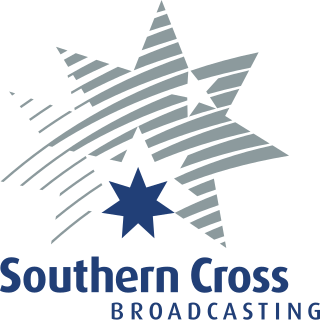| State/Territory | |
|---|---|
| Q | Queensland |
| N | New South Wales |
| C | Canberra |
| V | Victoria |
| T | Tasmania |
| D | Northern Territory |
| S | South Australia |
| W | Western Australia |
This is a list of Australian television call signs. When a television broadcaster in Australia is granted a licence, a call sign consisting of a unique series of letters and numbers is allocated by the Australian Communications and Media Authority and are unique for each broadcast station. [1]
For commercial networks, these are generally three letters. The first two letters are selected by the licensee, and the third letter often indicates the state or territory in which the station is located. Sometimes the third letter is also used as part of the abbreviation or mnemonic to name the station - for example GTV (General Television Corporation) represents "General TeleVision" or "General TV", although the V stands for Victoria.
Call signs in Australia do not include ITU prefixes. If one is required, "VL" is used. So, for example, GTV in an international context would actually be "VLGTV".
With the onset of aggregation in regional areas and digital television, the call signs do not retain the meaning that they did in the past. Stations will sometimes change frequency, or have different frequencies at different locations, such as re-transmission sites, where the same signal is re-broadcast in a different area. However, the three-letter codes have generally not changed and are still used within the industry.
A list of call signs is shown below, with original explanations of the call signs as of July 2022. [2]

Television broadcasting in Australia began officially on 16 September 1956, with the opening of TCN-9, quickly followed by national and commercial stations in Sydney and Melbourne, all these being in 625-line black and white. The commencement date was designed so as to provide coverage of the Olympic Games in Melbourne. It has now grown to be a nationwide system that includes a broad range of public, commercial, community, subscription, narrowcast, and amateur stations.

Southern Cross Broadcasting (Australia) Limited was a diversified Australian media company, that owned and operated a variety of media businesses, primarily in radio and television.

WIN Television is an Australian television network owned by WIN Corporation that is based in Wollongong, New South Wales. WIN commenced transmissions on 18 March 1962 as a single television station covering the Wollongong region. The WIN Network has since grown to cover much of regional Australia. The network's name, WIN, originates from its first station, Wollongong's WIN-4. WIN has a program supply agreement with metropolitan broadcaster Nine Network, covering its stations in Regional Queensland, Southern and Western New South Wales, Griffith, Regional Victoria, Mildura, Tasmania, Eastern South Australia, and Regional Western Australia. WIN also has a program supply agreement with third-placed metropolitan broadcaster Network 10, for its Northern New South Wales station. WIN also produces and broadcasts weeknight half-hour local news bulletins across its Queensland, southern New South Wales, Victoria and Tasmania markets, as WIN News.
TVT is Tasmania's first television station, delivering its first official broadcast on 23 May 1960. The callsign stands for "TeleVision Tasmania". Unlike the commercial stations in Sydney, Brisbane, Melbourne, Adelaide, and later Perth, TVT held a monopoly in the Hobart market for many years.
Prime7, formerly Prime Television and other names, was an Australian television network. Prime Television launched on 17 March 1962 as CBN-8 in Orange, and later expanded to cover regional New South Wales, Victoria and the Australian Capital Territory. It was initially an independent affiliate owned by Prime Media Group before the network, and its sister GWN7, were acquired by Seven West Media on 31 December 2021.
GLV and BCV are television stations licensed to serve Traralgon and Bendigo and regional Victoria, Australia. The stations are owned and operated by Southern Cross 10.
10 is an Australian television network distributed by Southern Cross Austereo (SCA) in regional Queensland, southern New South Wales, the Australian Capital Territory, regional Victoria, the Spencer Gulf, and Broken Hill. SCA's network is the primary affiliate of Network 10 in most regional areas.
In Australia, regional television is the local television services outside of the five main Australian cities.

Southern Cross Media Group Limited, doing business as Southern Cross Austereo, is an Australian media company which operates broadcast radio and television stations. It is the largest radio broadcaster in Australia, operating 86 radio stations, and has a reach into every state and territory.
Imparja Television (IMP) is an independent Australian television station servicing over 3,600,000 km2 (1,400,000 sq mi), across six states and territories: Northern Territory, South Australia, Queensland, New South Wales, Victoria and Tasmania. It is based in Alice Springs, and is controlled by Aboriginal people through ownership by Imparja Television Pty Ltd.

AMV is an Australian television station licensed to, and serving the regions surrounding Wagga Wagga and Albury-Wodonga in south western New South Wales and north eastern Victoria. The station was, for many years, merged with RVN-2 as the Riverina and North East Victoria Television Service.
VTV is an Australian television station broadcasting in regional Victoria in Australia. The network was owned by ENT Ltd., before being purchased by the WIN Corporation.

QQQ is an Australian television station broadcasting in remote central and eastern areas of Australia, owned by Southern Cross Austereo. The station is available via satellite and terrestrial platforms – mostly through community retransmission sites, although it also transmits into the town of Mount Isa, Queensland under the call sign ITQ. The station is solely affiliated with the Seven Network.

MyTalk was a Fairfax Media television channel available to viewers of digital television in Australia. The datacast channel, launched on 13 April 2007, was designed to supplement the Southern Cross Ten and Southern Cross Television digital television services and the online portal. The channel was also localised for thirty markets to include international, national and local news, as well as weather updates.

Seven is an Australian television network distributed by Southern Cross Austereo (SCA) in Tasmania, Darwin, the Spencer Gulf, Broken Hill, and remote eastern and central Australia. SCA's network is the primary affiliate of the Seven Network in the areas it serves.
WIN News is a local television news service in parts of regional Australia, produced by WIN Television. 12 regional bulletins and news update services are presented from WIN's headquarters in Wollongong, and until 2021 included production of a national compilation programme shared between the city and Maroochydore.
Southern Cross Media Group is one of Australia's major media companies, as the parent company of Southern Cross Austereo. Its headquarters are in South Melbourne.

This timeline of Australian television lists important station launches, programs, major television events, and technological advancements that have significantly changed the forms of broadcasting available to viewers of television in Australia. The history of television in Australia can be traced back to an announcement from the Menzies' government concerning plans for television services in Sydney and Melbourne.
STV is an Australian television station licensed to and serving the regions surrounding Mildura, Victoria, owned and operated by the WIN Corporation and part of the WIN Television network. The station commenced transmissions on 27 November 1965.
CDT is an Australian digital television station broadcasting in remote central and eastern Australia. It is jointly owned by Southern Cross Austereo and Imparja Television Pty Ltd and operates under the company name Central Digital Television.